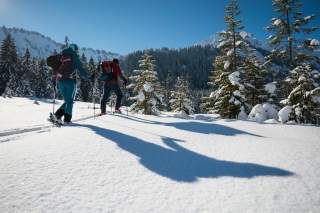1. Healthy and fit in the mountains
Ski tours are an endurance sports activity. The intense strain on the cardiovascular system as well as muscles and joints requires a healthy body and realistic selfassessment. Avoid time pressure and choose the right speed so that nobody in the group will get out of breath. Save some power reserves for skiing downhill.
2. Careful planning
Maps, guidebooks, the internet and experts inform you on the course of your route, its length, difference in altitude and the current conditions. Pay special attention to the weather forecast as cold, wind and bad visibility strongly increase the risk of accidents. Plan alternative routes. Get information on national mountain rescue emergency hotlines (Euro-emergency hotline 112).
3. Complete equipment
Adapt your equipment to the wintry conditions and the concrete destination. Standard emergency equipment is avalanche transceiver, probe and shovel as well as first aid kit, bivouac sac and mobile phone. An airbag increases your chances of surviving an avalanche. Check your equipment before heading out and carry along a repair set.
4. Avalanche report
Inform yourself thoroughly on avalanche danger before starting your tour: Why? Where? What? In particular, consider information regarding danger level (1-5), danger areas (where is it dangerous today?) and regarding danger patterns (what is the main danger today?).
5. Judging the risk of avalanches
There are tight limits on assessing the avalanche danger. Build your decisions upon strategic methods of risk evaluation (reduction methods) and learn to read signs of danger in the field. Avoid dangerous regions and turn around if necessary or in doubt.
6. Breaks and orientation
Drinking, energy supply and breaks are necessary to keep up your performance and concentration. Hot, isotonic drinks are an ideal thirst quencher and source of warmth. Check your position continuously for orientation (“I know where I am”) and critically assess already existing traces.
7. Keep a distance
Distances serve to relieve the pressure on the snow cover and to limit the damage. Adequate distances of 10 m in the ascent on steep slopes additionally make kick turns in hairpins more comfortable. When descending, always keep distances of at least 30 m and ski very steep slopes individually.
8. Avoid falling
Falling during the ski descent is the most frequent cause of injuries. For the snow cover this means an enormous additional load. A good skiing technique and speed adapted to the individual abilities reduce the overall risk. A ski helmet protects you from head injuries. Caution: danger of falling in case of iced snow cover and on rocky grounds!
9. Small groups
Small groups (up to 6 people) increase safety. Communication with other winter sports enthusiasts and mutual consideration may prevent dangerous situations. Stay together. Inform trusted persons on destination, route and return conditions. Caution when you are alone: Already little incidents may lead to severe emergencies.
10. Respect Nature and the Environment
Mountain regions offer great opportunities to move freely in unique wilderness. Enjoy that freedom! Be considerate of wild animals, respect natural reserves and do not enter reforestation areas. Use public transport or a car pool to get to your point of departure.
